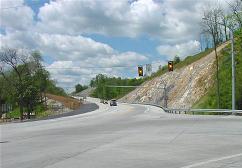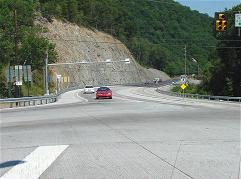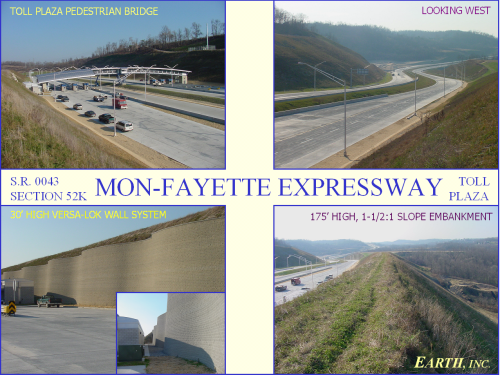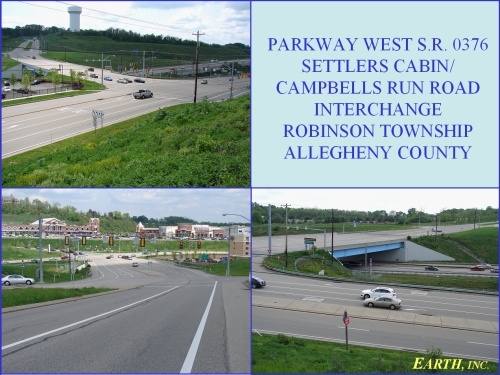Roadway
Pennsylvania Turnpike, Milepost 84
Westmoreland County, PA


The incorporation of a 1,150-foot long geogrid-reinforced embankment with concrete masonry unit facing (segmental block retaining wall) using milled bituminous pavement as structure backfill saved more than $500,000 in construction costs for a 9-mile total reconstruction section of the "original" Pennsylvania Turnpike. This wall is at the top of a very steep (approaching 1:1) existing slope. A soldier beam and lagging type wall was not deemed appropriate because of numerous hard boulders in the underlying material. "Traditional" MSE walls were not expected to provide the economies that the segmental block retaining wall did.
S.R. 0022, Sec. 005 (Water Street Bypass Intersection with S.R. 0453)
Huntingdon County, PA


The use of steepened cut slopes at two locations on the order of 100 feet in height with rockfall drop zones at the intersection of S.R. 0022 with S.R. 0453 provided for rockfall mitigation and significant cost savings as part of the 1.8 mile relocation of S.R. 0022 in Huntingdon County. Retaining wall in lieu of steepened slope construction would have resulted in a ten-fold increase in costs for the two areas. Slope flattening was not an option as such excavation would have resulted in the disturbance of a more than 200 year old cemetery at one location and the denuding of over 300 vertical feet of mountainside at the other.
Mon-Fayette Expressway, S.R. 0043, Section 52K Toll Plaza
Jefferson Hills Borough, Allegheny County
In order to provide for light shielding of the Toll Plaza from the surrounding Jefferson Hills community, it was necessary to create a faux cut effect, 30 feet in height, as part of the construction of a 175-foot high, 1-1/2:1 sloped embankment – in addition to a 30-foot high, geogrid reinforced retaining wall at the very top of this embankment.
Given the presence of an abandoned deep mine of the Pittsburgh Coal beneath the general area of the toll plaza, overexcavation and backfilling along with dynamic compaction were implemented to address the potential for mine subsidence on the project. In addition, given the condition of heavy mine drainage flow out of the buried mine workings, extensive subsurface drainage measures including the use of select rock for transmitting such drainage out from beneath the embankment was employed as an integral part of its design. Embankment design also included the use of several categories of zoned rock made up of select materials obtained from excavation on the project to develop the desired stability for such a high, steep embankment slope.

Parkway West S.R. 376, Settlers Cabin/Campbells Run Road Interchange
Robinson Township, Allegheny County
The Settlers Cabin/Campbells Run Road Interchange in the western suburbs of Pittsburgh was added to the S.R. 376 (Parkway West) highway to improve local access and regional mobility for an area that was poorly served, not only with regard to the current level of commercial development, but also future development and infrastructure expansion that were planned for the general project area at the time.
The project location presented a number of geotechnical challenges. Portions of the Parkway West and Campbells Run Road in the area of the interchange were constructed over the Campbells Run floodplain with large areas of non-engineered fill already in place over the project site, including end-dumped fill containing debris such as wood, concrete, and asphalt. In addition, areas of past strip mining of the Pittsburgh Coal were present along with deep mining beneath a portion of the project. Furthermore, areas of suspect slope stability were prevalent throughout the area of the project. As such, extensive overburden stabilization measures above the level of the deep mine were undertaken including overexcavation and backfilling as well as cement-flyash grouting – along with the implementation of slope stabilization measures in areas of excavation and embankment construction as part of the remedial earthwork required for the successful completion of the project.
Structures required as part of the development of this interchange included a 194-foot long, single span, 7-lane wide bridge over the Parkway West. Retaining wall construction was significant also, including 7 walls totaling over 4,500 feet in length. In addition, two drainage structures were incorporated as part of the project.
